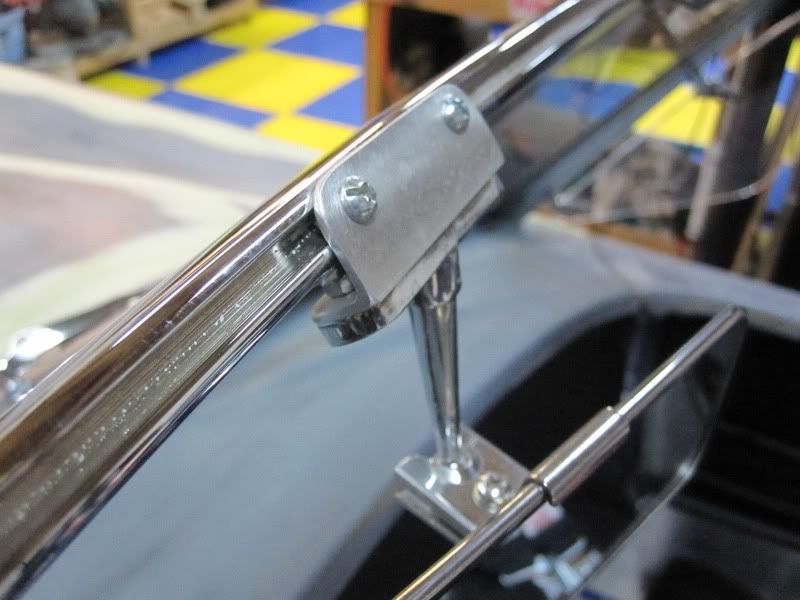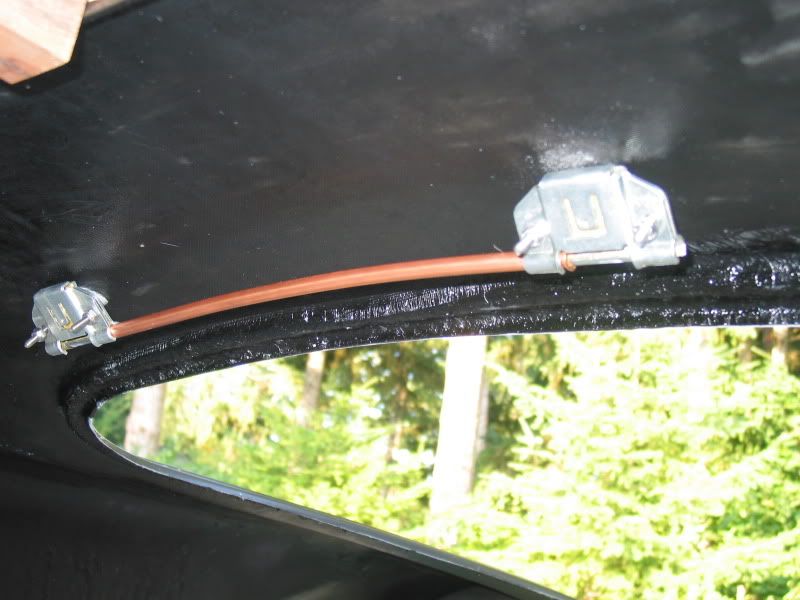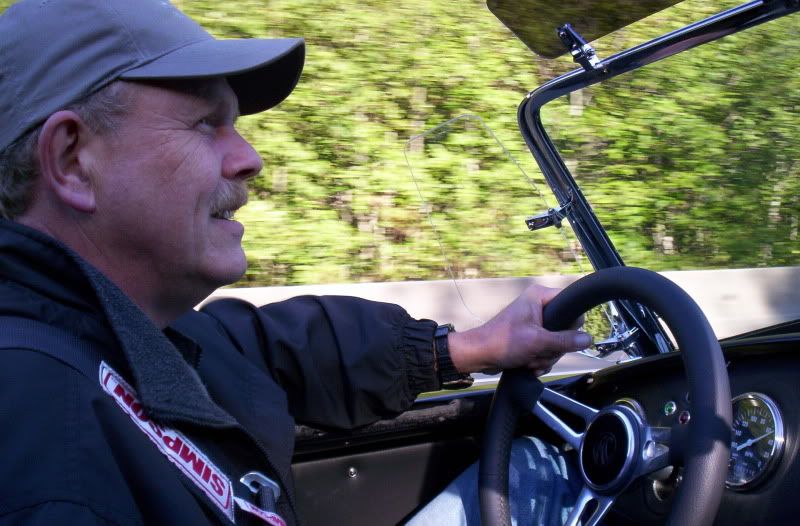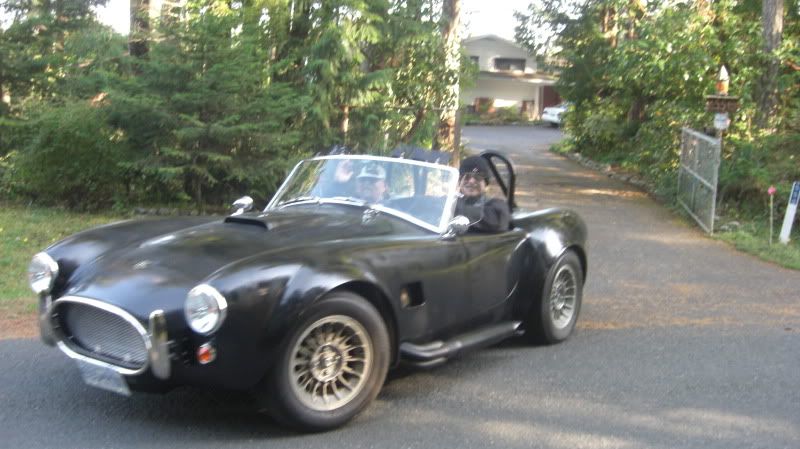I finally called the shop where I was going to get my safety inspection done, to confirm if they had rec'd my VIN tag form ICBC yet. It had arrived on the previous Friday. I set my appointment up tentatively for Wednesday, as the weather showed we may get a break from the rain..finally. I also scheduled a four
wheel alignment, and wheel balancing for the same time.
Wednesday morning it looked a little iffy weather wise, with still lots of grey clouds around, but at least it wasn't raining. I taped the Temporary Operating Permit to the trunk, as there is no side or rear window to stick it to, as the instructions indicated.
My first time on the road,,legally..was pretty darn exciting. My first stop was at the MOT highway scales, which fortunately were open, as their hours are a bit of a guess. The MOT website shows them open from 6am to 6pm daily, but many times I have driven past and seen the "scales closed" sign was up. The scales were very busy with trucks passing over them at a rate of about one a minute. I went in to the office, and explained what I needed, and why. They had no problem with it, and told me to drive around to the scales, and to watch the electronic sign board, for what I needed to do, step by step. I pulled on to the scales, once the sign said to
proceed, and sat with the engine idling, watching the sign to see what to do next. I could see the weight displayed on another electronic board, and figured the sign would indicate to pull off the scales, but nope..I just sat there. I looked towards the office, and I could see the MOT guy was trying to tell me something. I couldn't hear SFA as the roadsters side pipes pretty well drowned everything out. He was waving his hands around at the same time, so I thought that perhaps he wanted to get each individual axle weight or something, I pulled forward a tad so the front wheels were off the scales. Nope, that's not what he wanted he indicated for me to back up.
Finally my buddy came out of the office, where he was waiting to pick up the scale ticket for me, and yelled, "Get out of the car"...Oh.. that's what they wanted,...the cars weight only.. duh..I felt pretty stupid..In the meantime there was a line up of semi-trailers lining up behind me, probably pissed at me for taking so long..sheesh..
Anyhow, the Cobra weighed in at 1030kg with some tools in the trunk, and a 1/4 tank of fuel. That's 2260 pounds for the metric challenged..lol
My appointment at the inspections shop wasn't until 10 am, so we took a bit of a round about route heading there. The car felt great, and I was really surprised how well it tracked, with our simple string and measuring tape wheel alignment.
The tech that was going to do the inspection came out to the car once I booked in, and was really impressed with it right off the bat. That's a good sign I figured. He asked a lot of questions about the build, and as to what parts where new, which were used. He seemed pretty pleased that the
brake rotors where all new, likewise with the ball joints,
tie rod ends, and suspension bushings. He obviously wasn't familiar with the original Cobras having a V8 in them, as he was really surprised when I opened the hood and he saw the 5.0 engine in it. I suppose that simply looking at the car, one may think it only had a four banger, due to it's small size.
As soon as a bay was free, he asked me to pull into it, and then we went over all the light functions, horn, wipers, etc.. He checked the
headlightalignment, which is something I hadn't done, but as it turns out was dead on the money..Now how's that for a good omen..lol
Once he finished that he jacked the car up and inspected the underside as best he could..again he seemed very impressed with the construction overall.
The alignment rack was free, so he got me to move it over. First the thrust alignment was checked, This is to ensure the back axle is true and square with the frame. Sure don't want the crab walk stance while driving. There was very little adjustment needed, as I had done a pretty thorough job of checking this previously. The front wheel camber and caster took quite a bit of time. The computer didn't have the specs in it for this car, so he manually over rode the Mustang specs, and set it to the ones I brought him, that the FFR build manual shows to use.
The whole process took several hours but overall the price wasn't bad at all. They had set prices for both the inspection process and for a four
wheel alignment, and I wasn't charged any extra, even though I'm sure it took twice as long for the alignment then it would for a normal car.
INSURANCE AND REGISTERING
With the safety test "passed" form in hand, I then went to the ICBC Autoplan agent to get my plates, insurance, and registration done. The young lady (cute too) was very good at the process, and had it all done within fifteen minutes. She had to come out to the car to make sure the VIN tag that the shop attached was correct for the registration. I think that "neat" was the word she kept using, when she saw the Cobra first hand..
I pulled the TOP sticker off the trunk, and fastened the new plates, and was ready for some cruising..What a great relief that whole process is now behind me! YEEHAW!!
FIRST REAL CRUISE
The sun came out for a little while, and I figured I better go for a test ride.
I had read several builders of these cars complaining that when filling their
fuel tanks, that the gas would back up in the filler tube and trip the nozzle over and over. For them filling the car can be a long slow process. I was a little worried this may be the case for me, as so far I had only added gas with a jerry can. Not to worry as it turns out, the gas filling was as normal as any other car I've owned. I could run the pump at full speed.
I tooled around town for a few minutes, before deciding to take it up to the highway for a blast. The speed limit is 110kph, and the Cobra had no trouble quickly reaching the limit as we left the entrance ramp. The acceleration is mind boggling, and can really snap your head back when you step on it even just a tad..
The car felt as if it was just coming into it's own at that speed, and even with the 3.55 gears had plenty left. You could easily cruise in 4th gear at 110, 5th was almost to high a gear, but it still pulled good when I stepped on it.
The car handled rock steady at speed, and the wind was not as much an issue as I felt it might be. Very comfortable!
I returned home, and took the Wife out for a cruise. Several builders have stated that their wives/girlfriends refused to ride in the car after their first ride. I have no idea what those cars rode like, but my Wife was really impressed. She had a grin as big as mine as we tooled along at 110. She was
really impressed with the heater, as by this time the clouds were back, and it was cooling down quite a bit. I gave her a few samples of the cars acceleration..she loved it! I though that was pretty cool..
I headed home and gave the car a thorough once over to look to see if any leaks had developed, or if anything looked out of kilter, but all looked tight and dry.
The weather turned ugly again on Thursday, and Friday was pretty bad as well. Saturday the roads looked dry enough for another cruise, so I took my Son out for his first blast. He was very surprised at the acceleration, and had a hard time describing it later when asked by others, how he liked the ride lol. He kept saying it was a lot faster than he ever imagined it would be. I think he was also surprised at how I managed the standard tranny. He has never driven one himself. He also was impressed with the cars ride, cornering ability, tracking and smoothness.
Now please note; I never exceeded the speed limits while driving the car, but simply got to the limits very, very, quickly..There is no laws against that, as far as I know..I also never did any burn outs, or drove wrecklessly. I think I can have some pretty good fun in this car without ever driving stupidly.
BUILD CONTINUES
So although the car is road worthy, there are many items that need to be finished, at least temporarily until I'm ready to get the paint and bodywork done.
The first thing I need to do, is to seal off the back of the cockpit in the rear wheel areas. There is a few gaps along the back of the rear cockpit bulkhead, where the body sits. I am thinking I may be able to get away with aluminium tape, as I don't want to do anything to permanent quite yet. Some builders use silicone to seal these areas, but as I need to remove the body at a future date, I don't want to have to worry about trying to cut silicone out.
I have heard of some builders complaining about rocks and road debris, bouncing off the aluminum panels, and sounding kind of tinny. Perhaps it's the insulation I used, along with the Dyanliner, but I really didn't notice this as being a problem. I have some undercoating spray that I plan on using, and I suppose I should apply this before the aluminum panels get dirty from driving, and need to be cleaned. This will entail a fair amount of masking, as I don't want this undercoating all over my Koni coil over shocks, or other suspension components. I'll just have to take my time. and do it carefully.


















































